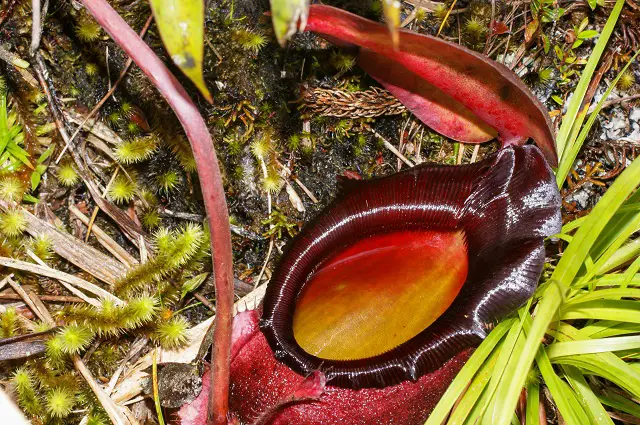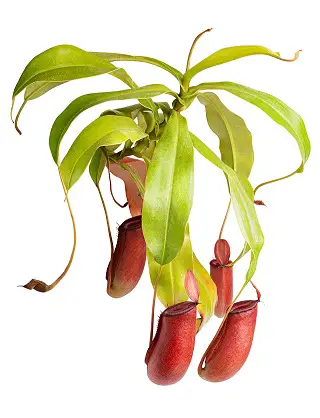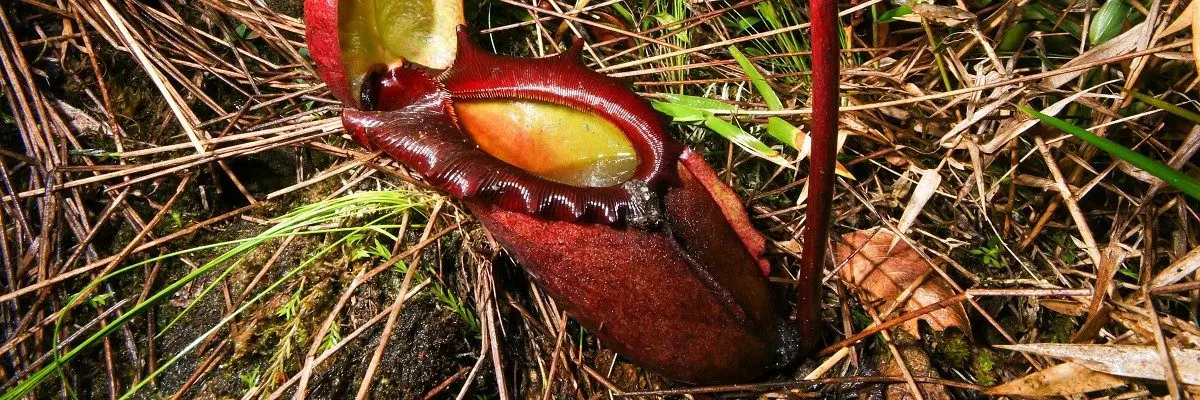No matter the precise criteria you use to determine the world’s largest carnivorous plant, there is little doubt that the winner in terms of overall plant size would be Nepenthes rajah – a tropical pitcher plant found mostly in parts of south-east Asia, specifically Indonesia, Malaysia, and the Philippines. A huge vining plant in nature, some plants can attain heights of more than 25 meters (82 feet) in the treetops, forming large, clumped growths. Especially in western Sumatra, Indonesia, vine thickets have been observed to grow in deep forest situations.
By volume, Nepenthes is also the genus with the largest carnivorous plant traps. In particular, the giant montane pitcher of Malaysian Borneo has pitchers that can hold up to 3.5 liters of water (118.3 ounces) or 2.5 liters of digestive fluid (84.5 ounces). These plants have consumed frogs, birds, and even rats.
Another contender named in honor of Sir David Attenborough, Nepenthes Attenborough, has only recently been discovered. With its massive and colorful pitchers, this tropical pitcher plant was only found in 2009 and is highly endangered in its natural environment. It can grow up to 1.5 meters (4.9 feet) tall. Rodents and other small animals can be captured and digested in their 30 cm (11.8 inches) diameter pitchers.
What is the Nepenthes rajah?
In the genus Nepenthes, Nepenthes pitchers are one of the biggest. And is also known as the rat trap plant. Nepenthes rajah is named after Joseph Hooker. Charles Darwin was his friend, and his “Flora of British India and Genera Plantarum” are famous books. Since monkeys have been witnessed drinking water from Nepenthes species, the genus is sometimes called monkey cups.
Known for its giant pitchers, Nepenthes rajah easily catches and digests animals. A large amount of prey consists of insects, particularly ants. There is, however, reliable evidence that this species has caught rats on occasion.
Nepenthes Tropical Pitcher Species
The genus Nepenthes consists of over 200 species of scaling plants with carnivorous tendencies. These large plants grow as vines, bearing large pitchers. Tropical pitcher plants received the name ‘Monkey Cups,’ as an urban myth surrounds them stating that monkeys have been seen drinking water from them. The Nepenthes plant is found worldwide, although its main distribution area is Southeast Asia. Pitcher plants are native to tropical countries such as Australia, Indonesia, Borneo, New Caledonia, China, and the Philippines.
How Do Nepenthes Trap Insects?
A pitfall trap develops from the pitcher plant leaves, and it can take months to grow before it reaches full size. Though the traps do not move to catch prey, they are large and will trap a wide variety of insects, including ants and wasps. There are pitfall traps on Nepenthes filled with digestive juices. Nectar from the plant attracts insects, which in turn feed the plant. Insects approach the pitcher to try the nectar and then slip into the trap.
Pitcher plants grow in various environments, including the highlands and the lowlands. Highland Nepenthes species are the most common. A ‘Highland’ Nepenthe grows in the mountains at the height of around 3000 feet or 914 meters, with usual rains and high humidity. Those that grow below the elevation of 3000 feet (914 meters) in open areas such as fields and forests are called ‘Lowland’ Nepenthes. Furthermore, there are a variety of hybrids that can be The plant is either naturally occurring or is artificially produced by crossing two or more types of Nepenthes.

How long do Nepenthes plants live?
Plants of the Tropical Pitcher family can live for a long time, usually 10-20 years. The plant will grow new shoots every year that will turn into rosettes over the course of 5-10 years before it flowers. The plant will continue to grow stems after it has flowered. It will continue to grow like this throughout its lifespan.
What Environment do Nepenthes need?
The soil for Tropical Pitcher plants should be moist and well-drained; This will help them thrive. But Nepenthes need light, aerated soil, acidic that is not soaked in water. Alkaline soil mixed with sand is ideal growing conditions for some Nepenthes. Rainfall and fogs maintain the soil moisture of Pitcher Plants in their natural habitat. Due to their diet of insects, the soil needs to be deficient in nutrients allowing this disadvantage can be compensated for.
What is the ideal temperature for Nepenthes plants?
There is a difference in the temperature for Highland and Lowland Nepenthes based on their growing location. During the day, Highland species prefer temperatures between 75-78.8 Fahrenheit and 24-26 Celsius during the day. Highland species prefer temperatures between 53-61 Fahrenheit and 12-16 Celsius at night.
In the Lowlands, the ideal temperature ranges between 82 and 95 Fahrenheit or 28 and 35 Celsius during the day and 64 to 75 Fahrenheit or 18 and 24 Celsius at night.

Do Nepenthes plants become dormant in winter?
In winter, Nepenthes shouldn’t go into complete dormancy. Throughout the year, lowlanders require high temperatures and bright light. Highlanders can survive temperature drops, but their growth will be slowed. Maintaining the same conditions year-round is recommended for keeping Nepenthes.

